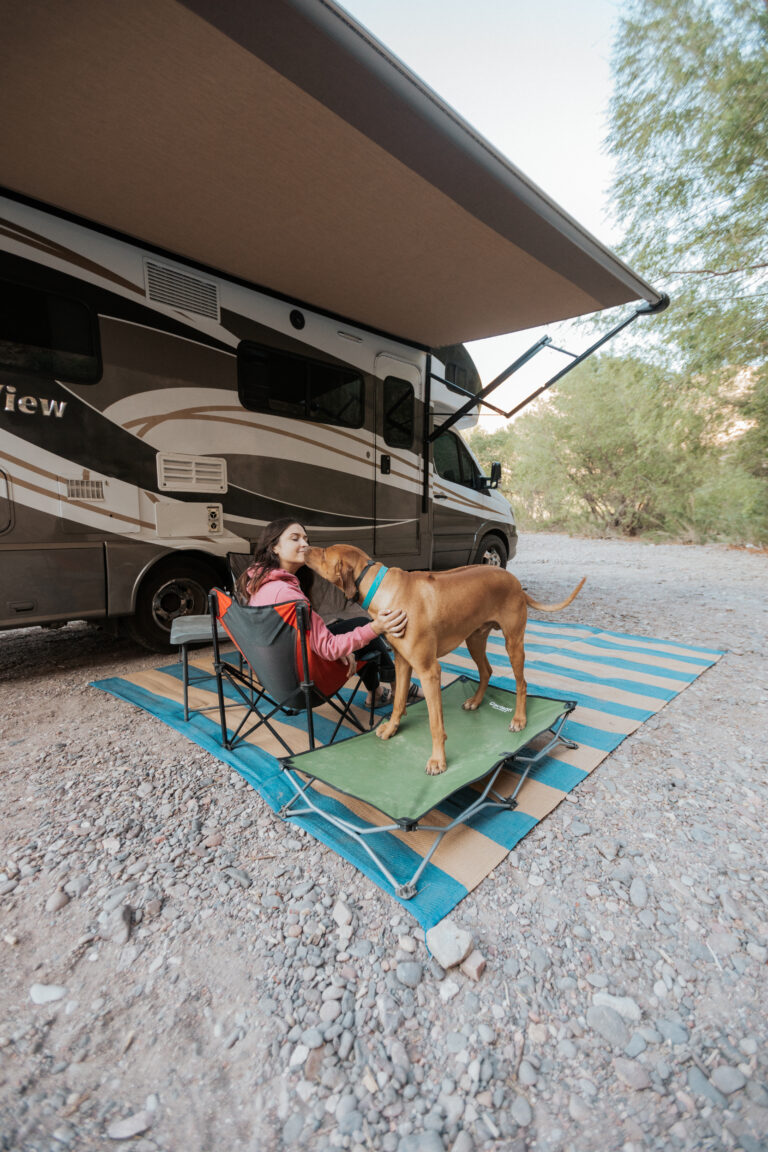
Most of the time, it’s not that difficult to stay comfortable when you’re living in an RV. After all, they’re specifically built with comfort in mind: You’ve got your bed, kitchen, living room, and even TV along for the ride.
But none of that means anything if you’re too busy sweating to care about cuddling in bed, whipping up breakfast, or even catching up on your favorite show.
Living in an RV in the summer months presents its own special challenges, especially if you’re traveling somewhere extra steamy — like the beautiful American Southwest. When the temperatures climb over 90 degrees, even the best rooftop air conditioning unit in the world may struggle, especially if your rig is older or not very well insulated.
But luckily, there are some simple RV comfort solutions, even in the most brutal summer heat.
Here’s how to live comfortably in an RV, even when the weather outside is too hot to handle.
How to Keep an RV Cool in Summer
If you’ve been waiting for your epic road trip all school year, only to realize the temperatures are steadily rising, you may be asking yourself, “How do I get my RV ready for summer?”
Even the most incredible itinerary in the world can be spoiled if you and your family are too hot to have any fun.
But one of the simplest ways to keep your RV cool and comfortable is so obvious, you’ll be surprised you didn’t already think of it.
1. Plan your travels around the weather.
Yes, summertime is one of the best times to travel for many people, not only because the kids are out of school but also because, in the northern climes, the snow has finally melted and the sun is shining.
But that doesn’t mean you have to head as far south as possible as quickly as possible!
The summer is a great time to take on destinations that might be chilly to fully enjoy in other seasons, like the historic Northeast or the Pacific Northwest. You can even take on outdoor activities like hiking, biking, kayaking, or horseback riding, which might be inaccessible in the winter.
As an added bonus, of course, your RV will naturally stay cooler… because you aren’t in Death Valley! (Save that trip for fall.)
2. Choose shady spots for natural insulation.
When it comes to choosing a camping spot, there’s already a lot to take into consideration. You want to ensure your campsite is level, dry, and close to the activities and amenities you care most about. You’ll already need to decide between choosing a privately owned resort campground, a state park, or boondocking on public land.
But in the summer, another good thing to look out for when scouting out a campsite is how much shade is available. Whether it’s tree cover or a manmade tent, shade will help passively cool your entire RV and let your A/C unit work just a little bit less intensely, which means it’ll likely keep working for much longer. Just be sure if you’re camped under sap-producing trees that you keep up with cleaning off your RV’s roof — otherwise, your paint job and finish might wind up super-sticky, or even become damaged.
3. Keep your shades drawn and use your awnings.
It might sound obvious… but you’d be surprised at how much that sunlight streaming through the window can heat up your rig!
When it’s really hot outside, keep your shades drawn to maximize your RV’s insulation. And take advantage of those awnings you have on each window — sure, they might be a pain to unroll and roll every time you want to move, but their shading and cooling capacity is pretty remarkable.

4. Consider investing in insulation upgrades for your rig.
If you own your own RV and plan on taking frequent summer travels, it might be worthwhile to consider making some permanent upgrades.
You’ll want to speak to a dealership rep or repair professional about the best ways to insulate an RV for summer, as it will vary depending on the model and type of rig you have. However, these upgrades might include installing better window shades and awnings, improving your air conditioning system, or even investing in some specialized, insulated body work. For a quicker fix, you can also look into adding floor fans and RV covers to use when the unit is in storage.
RV Comfort Thermostat
Staying comfortable in your RV doesn’t have to be difficult, although it does depend, to some degree, on how much heat you can tolerate. For instance, some people are happy enough when “room temperature” means 80 degrees Fahrenheit, while for others, the low 70s is about as high as the comfort threshold goes.
To get a better sense of where you fall on the spectrum, check your RV’s air conditioner output temperature — when you’re feeling too warm, too chilled, and just right. That way, you’ll know about what temperature you’re aiming for to create your own ideal conditions.
Then, you can use your thermostat to set your air conditioner’s automatic cooling temperature to the right level for you, which might not be quite as chilly as you first imagined. By learning you can tolerate higher temperatures, you can save both money on electricity or generator fuel, as well as wear-and-tear on your RV comfort control unit.
RV Pet Temperature Alerts
Although your personal comfort level might be negotiable, the health and safety of any pets you have on board is not.
It’s always critical to take your animals’ well-being into consideration when you’re road tripping in the summer, and RVing is no exception. Be sure to set your air conditioner to an appropriate level whenever pets are in the cabin, even while you’re driving, and never leave animals in an uncooled cab or motorcoach while you head out exploring. Even in relatively moderate temperatures, the inside of a vehicle can quickly become very, very hot, which is dangerous for your pets.
Besides, the whole reason you brought Fido along for the ride was so that he could come adventuring with you! So take advantage of the best way to stay cool in the summer, and get outside — and hopefully, into a nice, cool body of water.






